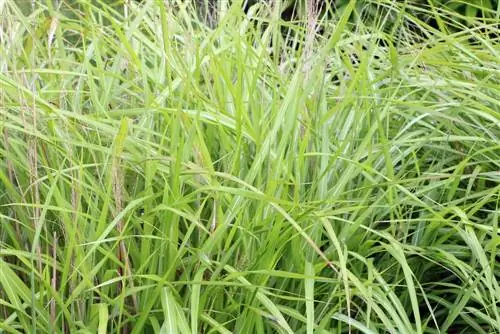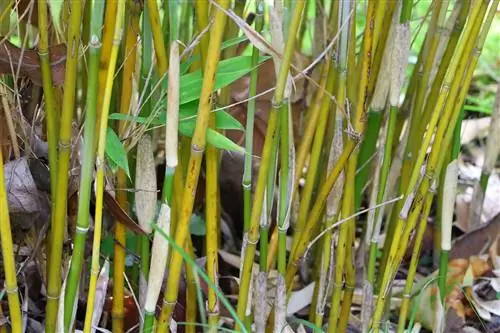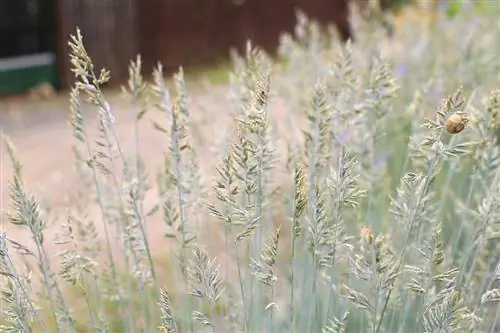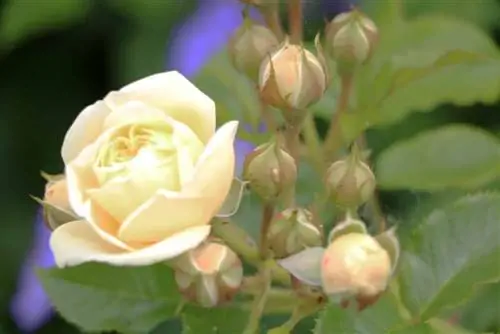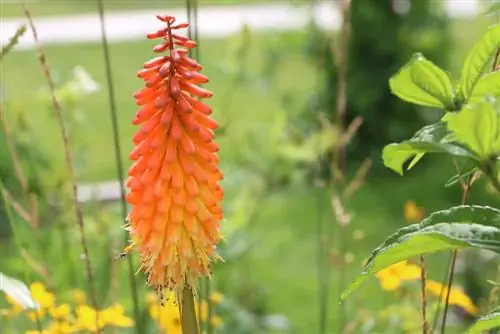- Author admin [email protected].
- Public 2023-12-17 03:39.
- Last modified 2025-06-01 06:48.
The leaves of the grass have two lines and arise from a sheath which either splits or bends over. The grass flowers appear in the form of grapes, panicles or spikes. Pollination of grasses takes place with the help of the wind.
Classification of grasses
The grasses are divided as follows:
- Sweet grasses (real grasses)
- Bamboo
- Grains
- Ornamental grasses
- Lawn grasses
- Red or sour grasses
- Cyprus grass (Cyperus)
- Sedges (Carex)
- Bulrushes
- Marbeln/Hainsimsen (Luzula)
- Bulrushes (Juncus)
Types of grasses
The leaves of different grasses have various shapes, sizes, structures and colors. By carefully selecting and cleverly placing the plants, you can enliven your garden and create attractive design accents. Many grasses also thrive in pots. However, when it comes to potted plants, special attention must be paid to adequate overwintering. Grasses can also be planted as privacy screens or as ground cover, for example. In addition to the growth habit, it is important to ensure that the location, soil and requirements of the plant harmonize with one another.
Place grasses attractively
Tall types of grass work particularly well when planted adjacent to herbaceous borders. Low grasses, on the other hand, can effectively form a high-contrast foreground for a bed. It is important to ensure that no creeping grasses that are too vigorous are chosen for such a purpose, so that they do not suffocate their bed neighbors. Most grasses love a free location and a permeable but moisture-retaining soil.
The following are particularly suitable forShady locations:
- Giant sedge - height 40 to 100 cm
- Broadleaf sedge - height 10 cm
- Shadow sedge - height 20 - 40 cm
- Forest sedge - height 20 to 50 cm
- Grove ledges - height 20 - 40 cm
- Forest marbel - height 30 - 60 cm
Forsunny to partially shaded locations are suitable:
- Pampas grass - height 80 and 250 m
- Broad leaf bamboo - height 200 - 300 cm
- Giant pipe grass - height 50 - 200 cm
- Silver spike grass - height 80 cm
- Eyelash pearl grass - growth height 30 - 60 cm
- Miscanthus - growth height 150 - 300 cm
- Schiller grass - height 15 - 30 cm
- Bottlebrush grass - height 50 - 90 cm
- Swing arm - height 20 - 40 cm
- Atlas fescue - height 60 - 100 cm
- Blue oats - height 30 - 100 cm
- Quim grass - growth height 20 - 40 cm
- Red sedge - height 40 - 50 cm
- Mountain sedge - height 15 cm
- Rasenschmiele - height 60 - 100 cm.
- Feather bristle grass - growth height 80 - 90 cm
- Tufted hair grass - height 30 to 80 cm
For theedge planting of bodies of water are popular:
- Morning star sedge - height 25 - 50 cm
- Cypersegge - height 40 - 80 cm
- Colorful plume of water - height 70 cm
- Dwarf rush - height 30 cm
- Pipe grass - height 40 - 80 cm
- Red reed grass - height 80 cm
- Pond rush - height 100 - 150 cm
Planting and relocating grasses
If you want to replant or relocate a grass, plan to do so in the spring when the plant emerges. It is best to move it before a rainy period, as the transplanted plant must be kept moist throughout until it has successfully grown in order to prevent it from wilting and dying.

From the end of March, most grasses should be planted in nutrient-poor soil. If the grasses are forest perennials, a mixture of soil and pre-composted leaves is the suitable substrate, while steppe grasses thrive particularly well if the soil consists of soil mixed with sand. When it comes to green grasses, it should be noted that the lighter the color of the grass, the wetter and shadier the planting location should be. If grasses have gray and bluish stalks, they thrive particularly well in dry and sunny locations. Dull, colorful grasses grow best in a partially shaded location in moist soil. Plant the grass so that its roots are completely covered. Grasses need a planting distance from other plants that is at least as large as their final growth height. For smaller types of grass this means a distance of around 30 to 75 cm, while for tall grasses a clearance of 120 to 150 cm is recommended. Since grass spreads slowly, the bed may initially appear bare. If you choose smaller planting distances, you have to accept that the grass will be divided earlier.
Ongoing care
Most types of grass are undemanding and grateful plants that hardly require any special care. Ongoing care is therefore limited to:
- Soil preparation (mulch, gravel and, if necessary, apply calcium silicate)
- Cut back (15 cm above the ground in spring)
- Restrict growth (by dividing and applying a rhizome barrier if necessary)
Propagate grasses
Perennial grasses can be propagated by division or from seeds. Annual grasses are propagated from seeds (sown in spring or autumn). Clump-forming grasses are propagated by division in spring or autumn. In the case of rhizome-forming species, these are cut into pieces. It is important to ensure that each partial rhizome has at least one shoot bud and that the fine roots are not injured, as they are important for growth.
Overwintering garden and container grasses
- Don't cut back grasses in autumn
- Tie the blades of grass together in the middle and at the top to form a bundle
- For sensitive grasses, cover the soil all around with fleece or leaves
- Keep non-hardy grasses in pots cool, bright and frost-free
Before choosing your grasses, understand their location needs. Nothing stands in the way of successfully establishing your grasses in the garden or in the pot.
What you should know about planting grasses in brief
Which grasses are suitable for which garden depends on the size of the plants, the color of the foliage and the requirements of the respective location, which can partly be seen in the shape and color of the inflorescences.
- Many ornamental grasses thrive in open, sunny places in the garden. They are a popular decoration for herbaceous beds and serve as an effective background for plants with striking flowers. One or two large species can also be planted as an eye-catcher in the middle of the lawn or on an area with uniform vegetation.
- Tall grasses such as pampas grass, giant feather grass and miscanthus look best in a mixed ornamental bed. All three species grow up to 300 cm high during flowering and form lush clumps of green leaves.
- Medium-tall grasses (from 60 to 120 cm high when in bloom), which are suitable for perennial or flower beds, are available in a wide selection. If you prefer grasses with green foliage, you can choose between forms with erect, compact or feathery spikes and those with branched panicles, whose spikelets move with the slightest breeze.
- Low grasses, whose height does not exceed around 45 cm, look best when planted on the edges of beds. This group includes the blue-green or blue-gray fescue species and the white-bordered honey grass.
- Annual grasses can be planted in a sunny spot to fill gaps between perennials or bushes, but they also get along well with other annual ornamental plants.
- Some sweet grasses prefer moist soil or even wet subsoil. This includes the approximately 60 cm high pipe grass, whose creamy white striped leaves form lush tufts.
- The specially created flax water zone at the edge of a garden pond or the moist bank area of a natural body of water offers good location conditions for marsh grasses, sedges, rushes and cattail plants. Most of the plants mentioned prefer sun, but can also tolerate shade.

